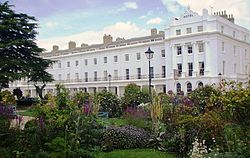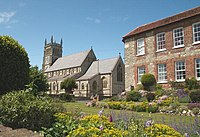Alverstoke
| Alverstoke | |
| Hampshire | |
|---|---|
 Part of The Crescent, Angleseyville | |
| Location | |
| Grid reference: | SZ603990 |
| Location: | 50°47’17"N, 1°8’44"W |
| Data | |
| Post town: | Gosport |
| Postcode: | PO12 |
| Dialling code: | 023 |
| Local Government | |
| Council: | Gosport |
| Parliamentary constituency: |
Gosport |
Alverstoke is a small village on the south coast of Hampshire, to the west of Gosport town centre, and now embedded in its expanded townscape. It stretches east–west from Fort Blockhouse, Haslar to Browndown Battery, and is centred half a mile east of the shore of Stokes Bay and near the head of a creek which extends a mile westward from Portsmouth Harbour.
Residents of Alverstoke have at times in the 20th century been called 'The Alverstocracy' by some residents of Gosport, in a tongue-in-cheek fashion, due to higher house prices and a perceived higher social status of the area.[1]
History
The name 'Alverstoke' is most likely to be derived from the name of an Anglo-Saxon Lady of the Manor, with with suffix 'Stoke' for 'settlement'. Alverstoke is mentioned in the Domesday Book as Alwarestock.[2]
Official Crown and Manorial records for the village refer to "The liberty of Alverstoke with Gosport", although the name has clearly evolved over the years:[3] from Alwarestoch or Halwarestoke in the 11th to 13th centuries, to Alvardestoke in the 14th century, to Aillewardstoke in the 15th century, and to 'Alverstoke' by the 16th century.
Until the early 19th century, the parish of Alverstoke measured some four and a half miles from north to south, and two and a half miles from east to west, covering most of present-day Gosport. The parish still stretched north, adjoining Fareham and Titchfield parishes.,[3] south to the Solent, east as far as Portsmouth Harbour, and west to the parish of Rowner, into the 20th century. However, large parts of the north and east of the parish were split into separate parishes between 1840 and 1913.
In the late 19th century Alverstoke became built up, and some of the fields separating it from Gosport disappeared.
By the early 19th century, as seaside towns became fashionable for polite society, an area known as Angleseyville was developed by the speculator Robert Cruikshank, and named in honour of the Marquis of Anglesey. This new area was to contain a racecourse, chapel, baths and pumphouse, and genteel gardens, a hotel, and fine townhouses emulating the grand Georgian crescents of the day but Cruikshank speculated on an architect who was only 21 and somewhat untested.
Although the hotel was erected first, such that purchasers could see what would be built, the scheme overall was not a financial success, and was therefore only partially completed. Its St Mark's Chapel had never become more than a chapel of ease to the local parish church only a quarter of a mile away, and was demolished by the early 20th century. Nonetheless, its small burial plot still contains 261 known burials, including many with high society connections: nine admirals, eight generals, two baronets, and various members of the Churchill, Nelson, Jellicoe, Walpole and Bonham-Carter families (and which started being used as a graveyard even before the chapel's dedication).[4]
Today, the Crescent stands as testimony to what might have been, but still only fulfils half of the original design. It does, however, still house the Anglesey Arms Hotel (where Queen Victoria is known to have stayed when travelling to and from Osborne House on the Isle of Wight – the train line used to run direct to Stokes Bay, where there was once a jetty). The Crescent is now Grade II* listed, and its award-winning Georgian-era gardens are open to the public to visit all year round.
Geography
The district and village of Alverstoke sits West, Northwest and immediately south of Stoke Lake, from South west of Haslar Road, Clayhall Road West side – towards Alverstoke Green, south to Crescent Road, west to Stokes Bay Road and up to the south side of Bury Road.
Several 'Palmerston's forts' are sited within the parish, including Fort Gilkicker, a 19th-century coastal battery fort, which is located at the eastern end of Stokes Bay, where it sits across a wide curved natural headland taken up by Gosport and Stokes Bay Golf Club. To the east is Fort Monckton.[5]
There is also an animal testing facility here.[6][7]
Churches
The Grade II listed parish church of St Mary is one of three Church of England churches in the parish: the three churches are:
- St Mary's
- St Faith's Church (by Tribe Road)
- St Francis, Alverstoke
- (A Chapel dedicated to St. Luke also exists within the grounds of Haslar.)
St Mary's is of mediæval origin, but has been significantly rebuilt and altered over the years. The original church was entirely replaced by the present structure, as designed by Henry Woodyer in the decorated style, when rebuilt 1863–85: its chancel was completed in 1865, and extends to three bays, two having arches to the north and south chapels; its wide nave by Woodyer was constructed in 1885 and has five arches and a south porch. Its western tower was built in 1906.[8]
Outside links
| ("Wikimedia Commons" has material about Alverstoke) |
References
- ↑ "Village of fear grieves for its lost serenity", Janine di Giovanni, Sunday Times, 24 May 1992
- ↑ "A History of Gosport", Gosport Borough Council
- ↑ 3.0 3.1 A History of the County of Hampshire - Volume 3 pp 202-208: The liberty of Alverstoke with Gosport (Victoria County History)
- ↑ Boundary wall to graveyard, listing with reasons.National Heritage List 1276302: @ (Grade @ listing)
- ↑ National Heritage List 1276716: Fort Gilkicker (Grade II* listing)
- ↑ "Goats used in Navy tests for 'the bends'". The Daily Echo. 2 March 2007. https://www.dailyecho.co.uk/news/1230852.goats-used-in-navy-tests-for-the-bends.
- ↑ Clement, Barrie (2 August 1998). "Goats used by MoD in submarine experiments". The Independent. https://www.independent.co.uk/news/goats-used-by-mod-in-submarine-experiments-1169273.html.
- ↑ National Heritage List 1232651: St Mary's Church (Grade II listing)

